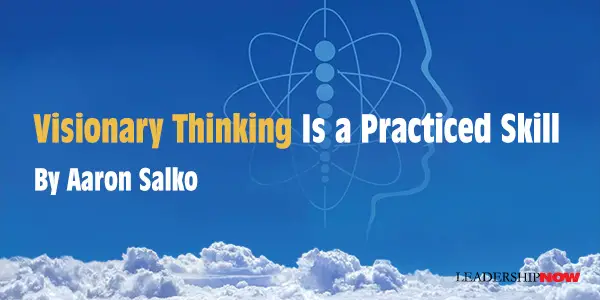 |
 |
12.15.23

Visionary Thinking Is a Practiced Skill
VISIONARY THINKING is the ability to see the big picture, envision what the future could look like, build a plan to achieve that vision, and lead yourself and others down the path of execution. First, you see things in your mind, and then you work both consciously and subconsciously to make them happen. In my younger years, I had many visions of the ideas, goals, and positions that I wanted to achieve. Some of them came to fruition. Some took me down other roads that led me to new experiences, which brought with them new visions. All were worth the effort and journey, and I realized very early on that visionary thinking was a major contributor to the success levels I had attained. As I looked back, I realized that most, if not all, of the 45 Performance-based Skills are utilized in some way during visionary thinking. It’s important to explain our society’s view of visionaries in order to shift your mindset away from thinking it’s unattainable. Having visions and being able to execute them will have an impact on the success levels you’ll achieve. Those who lack vision or don’t know how to identify and act on their vision will struggle with wealth attainment, achievement of goals, and personal fulfillment. When most of us think of visionary thinkers, names such as Thomas Edison, Albert Einstein, Steve Jobs, Elon Musk, Sheryl Sandberg, and Jeff Bezos come to mind. They’re viewed by many of us as “magical creatures.” That sets a high bar for the practice of visionary thinking. I’m not trying to downplay the incredible success these people have achieved, but I believe everyone is capable of being a visionary — you just need to develop the skills to identify the vision and then bring it to reality. Who knows, maybe one of your visions could be the next Amazon.com. A powerful vision creates the will to make change happen and harnesses the energy that will be needed. It inspires action and recruits the people and resources needed for new perspectives and ideas. It motivates individuals and organizations to commit to achieving the overall goal — no matter the number of roadblocks that get in the way. Here are the components that form the backbone of visionary thinking: 1. Cultivate a visionary mindset: To create a vision that elicits excitement and interest, you must give yourself the freedom to dream. Imagination is the key that unlocks the door to seeing and feeling what doesn’t yet exist. You must be bold in your thinking. To do that, you must allow yourself to think in the abstract. This entails battling against your own and our society’s programmed channels of thought. Then, integrate the abstract rationally into the real world in order to map the pathway to execution. 2. Tap into your subconscious: Your subconscious is the key to creating a pathway that makes a vision a reality. It’s important to get in tune with your intuition or gut instincts. Gut instincts are actually your subconscious directing your actions based on all the information it gathered while you were busy in your conscious life. In visionary thinking, you use your subconscious as a guidance tool. It will direct you as you navigate decisions, direction, and key components needed to create your vision. 3. Unleash your creativity: Have you ever been asked to “think outside the box”? If you are methodical and analytical, that statement probably makes you cringe. If you are artistic and creative, that statement most likely gets you excited. The reality is that creativity in your career environment is derived from both the need to solve a problem and the desire to avoid or solve future problems (which often leads to innovation). So, if you feel that you’re not a creative person, I will challenge you with the fact that you actually are because you’ve most likely had to create a solution to fix a problem at some point. This is the essence of creativity, although it goes well beyond problem-solving. It’s rooted in the deep desire to do things that go against the norm and push ideas that others may say are impossible. To be a wildly successful visionary, you must not fear creativity. 4. Hone your social skills: Having a vision is great, but unless you can help others see it and get them behind the execution, it will most likely die on the vine. This is why social interaction skills and boldness are so important to visionaries. They never do it alone. Visionaries get others involved and use the talents that surround them. Communication, trustworthiness, empowerment, networking, and likability are just some of the performance-based skills that you’ll need to optimize in order to influence others in the execution of your vision. 5. Embrace discomfort: When your mind is telling you that it has nothing to go on and lacks the ability to guide your path, embrace it! Nervousness is just your body preparing for action, and with the correct mindset, it can be a positive part of the process. Simply accept that you’re in an area of discomfort and that what happens next will bring with it experience, which in turn will raise your knowledge and confidence. When you embrace your discomfort and acknowledge your inexperience, the pressure reduces and the mind shifts. The best part of visionary thinking is that everyone is capable of it. The hardest part is taking the first step.  
Posted by Michael McKinney at 12:31 PM
|
BUILD YOUR KNOWLEDGE


How to Do Your Start-Up Right STRAIGHT TALK FOR START-UPS 
Grow Your Leadership Skills NEW AND UPCOMING LEADERSHIP BOOKS 
Leadership Minute BITE-SIZE CONCEPTS YOU CAN CHEW ON 
Classic Leadership Books BOOKS TO READ BEFORE YOU LEAD |